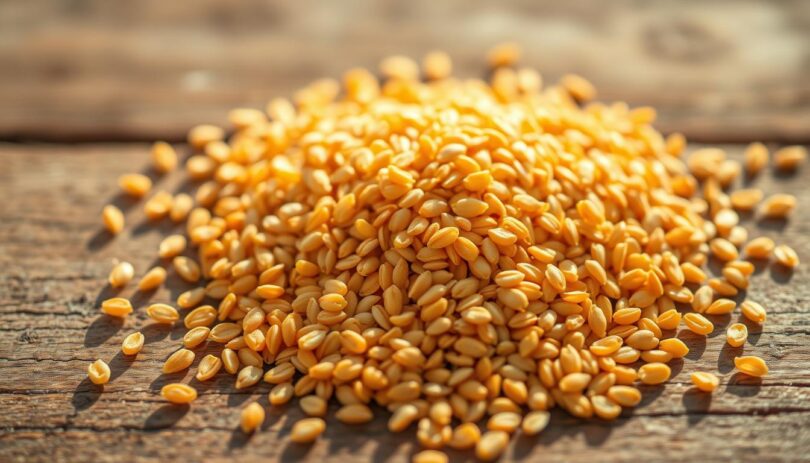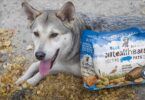Picture this: you’re sprinkling sesame seeds over a salad when your furry friend gives you that look. Should you share a pinch? Many pet owners wonder about adding these tiny seeds to their companion’s meals but hesitate due to conflicting advice.
Sesame seeds have gained attention in pet nutrition circles for their potential benefits. According to veterinary studies, they’re non-toxic and safe for most animals when prepared correctly. However, moderation is key—like many human foods, overindulgence can lead to digestive issues.
This article explores how these nutrient-rich seeds fit into a balanced diet. You’ll learn preparation tips to maximize safety and discover portion guidelines tailored to your pet’s size. We’ll also address common concerns, such as choking hazards and allergy risks.
Trusted sources like the American Kennel Club emphasize that while sesame isn’t harmful, it shouldn’t replace core components of your dog’s nutrition. Stay tuned as we break down the science behind this trending topic and help you make informed choices.
Understanding Sesame Seeds: Origins and Composition
Tiny yet mighty, sesame seeds have journeyed through millennia to grace modern plates. These golden specks trace their roots to ancient Africa and India, where they fueled civilizations and symbolized immortality. Today, they’re celebrated for their versatility in global cuisines and dense nutritional value.
Nutritional Profile and Key Nutrients
Each seed packs calcium for strong bones, iron for oxygen transport, and magnesium for muscle function. A single tablespoon delivers 1.5g of plant-based protein and 1g of dietary fiber. The presence of zinc supports immune responses, while omega-6 fatty acids promote skin elasticity.
What makes these seeds stand out? Their 50% fat content comes primarily from polyunsaturated acids. This composition helps maintain cell membranes and hormone balance. Though small, they provide B vitamins like niacin and folate for energy metabolism.
Historical and Culinary Uses
Archaeologists found sesame remnants in Mesopotamian tombs dating to 3500 BCE. Ancient Egyptians ground them into oil for lamps and medicine. In Asian cultures, they became tahini paste and goma-shio seasoning.
Modern kitchens use them in sushi rolls, burger buns, and energy bars. Their nutty flavor enhances both sweet and savory dishes. When toasted, they release aromatic oils that elevate textures in salads and stir-fries.
Why Sesame Seeds Attract Dog Owners
As dietary awareness grows, these nutrient-packed additions are gaining traction in pet care routines. Owners increasingly seek natural ways to enhance their companion’s meals without artificial additives. Research shows specific components in these tiny powerhouses may support vital bodily functions when used appropriately.
Nutritional Advantages for Four-Legged Friends
Rich in fiber and healthy fats, these edible specks can aid digestion when sprinkled sparingly on meals. Their calcium content supports bone strength, while zinc contributes to immune resilience. Many pet parents report shinier coats and improved energy levels after introducing small quantities.
Skin and Coat Support Through Essential Fats
The omega-6 fatty acids in these seeds play a key role in maintaining skin moisture and fur texture. These nutrients help reduce flakiness and promote elasticity, particularly beneficial for breeds prone to dryness. Always balance intake with other dietary fats to prevent imbalances.
Veterinary experts emphasize that benefits only manifest through careful portion control. Overfeeding may counteract positive effects, so consult your vet before making dietary changes. Later sections will explore safe serving methods tailored to different breeds and sizes.
Can Dogs Have Sesame Seeds? Safety and Nutritional Insights
Pet owners often question whether these crunchy additions align with veterinary dietary standards. While not toxic, sesame seeds require careful handling to ensure pet safety. Their small size poses choking risks, especially for smaller breeds, and whole seeds may pass undigested through the system.
Grinding seeds into powder boosts digestibility and nutrient absorption. This preparation method prevents intestinal blockages while preserving beneficial elements like calcium and zinc. However, even processed seeds should constitute less than 10% of daily caloric intake to avoid weight gain from their fat content.
Sesame oil deserves particular caution. High concentrations of omega-6 fatty acids can disrupt nutritional balance when consumed regularly. Always opt for raw, unsalted seeds over oil-based products to minimize gastrointestinal irritation.
Consulting a veterinarian remains crucial before introducing new foods. They can identify allergies through elimination diets or blood tests. Watch for symptoms like itching or diarrhea, which may indicate sensitivities.
Three safety practices maximize benefits:
– Crush seeds thoroughly before mixing into meals
– Limit portions to ¼ teaspoon per 10 pounds of body weight
– Avoid flavored or seasoned varieties
Properly prepared, these seeds offer trace minerals without compromising dietary priorities. Pair them with lean proteins and vegetables for balanced nutrition tailored to your companion’s needs.
Potential Health Benefits of Sesame Seeds for Dogs
Nutrient-rich additions to meals can play a surprising role in supporting vitality. These tiny powerhouses deliver concentrated nutrition when used thoughtfully, offering more than just flavor enhancement.
Essential Vitamins and Minerals
Calcium and magnesium work together to maintain strong bones and steady nerve function. A tablespoon provides 88mg of calcium—equivalent to 7% of a medium-sized pet’s daily needs. Antioxidants like sesamin combat cellular damage, particularly helpful for senior companions.
High-quality plant-based protein (1.5g per serving) aids muscle repair after exercise. Soluble fiber promotes gut health by feeding beneficial bacteria. For active pets, zinc supports immune defenses during outdoor adventures.
Omega-6 fatty acids contribute to glossy coats, while iron helps transport oxygen through the bloodstream. Studies show these nutrients may reduce joint inflammation in aging animals when paired with a balanced diet.
Moderation remains critical. Sprinkle crushed varieties over regular meals twice weekly for optimal absorption. Always combine with lean meats and vegetables to create complete nutrition tailored to individual needs.
Potential Risks and Dangers of Sesame Seeds to Dogs
While sesame seeds offer nutritional perks, exceeding safe limits can create health complications. Pet owners must recognize that even beneficial foods require careful handling. Overfeeding these tiny additives may trigger stomach upset, particularly in sensitive breeds.
Gastrointestinal issues top the list of concerns. Consuming more than ¼ teaspoon per 10 pounds of body weight often leads to diarrhea or vomiting. The high fat content—50% by weight—poses risks for weight gain if portions aren’t controlled. Regular overconsumption could contribute to obesity over time.
Whole seeds present choking hazards, especially for small companions. Grinding them into powder reduces this danger while improving nutrient absorption. Unprocessed varieties might also irritate the intestinal lining, causing blockages in extreme cases.
Sesame oil introduces additional risks due to concentrated omega-6 acids. Excessive amounts disrupt fat balance, potentially worsening skin conditions. Always choose raw, unsalted seeds over oil-based products to minimize digestive issues.
Three critical precautions:
– Monitor for allergic reactions like itching or swelling
– Introduce gradually alongside regular meals
– Consult your vet before dietary changes
Veterinary guidance ensures personalized advice based on breed size and health history. When used in moderation, these seeds remain safe for most pets. Balance their use with core nutrients to maintain overall wellness.
How to Safely Introduce Sesame Seeds into Your Dog’s Diet
Adding new ingredients requires strategy to ensure digestive comfort. Start with a tiny pinch of ground seeds mixed into regular food. Observe for 48 hours before increasing quantities.
Tailored Portions for Every Size
Small breeds under 20 pounds thrive with 1/8 teaspoon weekly. Medium companions (20-50 lbs) handle 1/4 teaspoon twice weekly. Larger animals above 50 pounds can safely consume 1/2 teaspoon spread across three meals.
Optimizing Seed Preparation
Grind raw seeds into powder using a coffee grinder or mortar. This breaks down tough outer layers, releasing nutrients while preventing choking. Avoid roasted varieties—high heat destroys beneficial fats.
Mix the powder with wet food or yogurt for better absorption. Never serve whole seeds or oil-based products. Treat these additions as occasional enhancers, not daily staples.
Key reminders for owners:
– Store ground seeds in airtight containers to preserve freshness
– Combine with fiber-rich vegetables like pumpkin
– Skip flavored or salted options
Track reactions through a food journal. Note energy levels, stool consistency, and skin health. Consult a vet if unusual symptoms arise after introduction.
Frequency Guidelines for Serving Sesame Seeds
Establishing a feeding routine prevents nutritional imbalances while allowing pets to enjoy diverse flavors. Most veterinary guidelines suggest offering these additions two to three times weekly. This rhythm maintains variety without overwhelming digestive systems.
Portion control proves essential. Measure each serving using kitchen scales or measuring spoons. For a 30-pound companion, ¼ teaspoon of ground seeds per meal works well. Spread servings across different days rather than consecutive meals.
Consistency matters more than quantity. Small weekly amounts deliver sustained benefits better than occasional large doses. Pair them with rotating protein sources and vegetables to create nutritional harmony. This approach aligns with the 90/10 rule: 90% core nutrition, 10% supplemental foods.
Schedule annual check-ups to confirm the feeding frequency suits your pet’s evolving needs. Bloodwork can detect potential nutrient excesses or deficiencies. Older animals or those with health conditions might require adjusted schedules.
Balanced diets thrive on diversity. Alternate between approved seed types and other safe supplements like flax or chia. Trusted sources like the ASPCA emphasize that rotational feeding prevents boredom and supports holistic wellness.
Alternatives to Sesame Seeds for a Nutritious Dog Diet
Exploring nutritional variety helps pet owners craft balanced meals while minimizing overreliance on single ingredients. Several seed options deliver comparable benefits with unique advantages, allowing tailored approaches to dietary enrichment.
Comparing Hemp, Chia, and Pumpkin Seeds
Hemp seeds outshine others in protein content, offering 10g per ounce alongside omega-3 fatty acids for skin health. Chia varieties provide 5g of fiber per serving—ideal for pets needing digestive support. Pumpkin seeds supply iron and vitamin K, supporting blood health and bone density.
Omega fatty acid ratios differ significantly. Hemp delivers a balanced 3:1 omega-6 to omega-3 ratio, while chia focuses on omega-3 dominance. Pumpkin seeds contain moderate omega-6 levels but excel in zinc concentrations for immune function.
Preparation methods vary by type. Grind hemp seeds into powder for better absorption. Soak chia seeds in water to create a gel-like texture that prevents choking. Roast pumpkin seeds at low heat, then crush them into small flakes.
Portion guidance depends on size. For a 30-pound companion:
– Hemp: ½ teaspoon twice weekly
– Chia: ¼ teaspoon daily mixed with food
– Pumpkin: 1 teaspoon weekly (roasted)
Select options based on specific needs. Pumpkin works well for digestive regularity, while hemp supports active pets with higher protein demands. Always introduce new seeds gradually and consult a veterinarian for personalized advice.
Understanding Allergies and Dietary Sensitivities in Dogs
Dietary sensitivities can surface unexpectedly in pets, even with seemingly harmless ingredients. While many animals tolerate seeds well, reactions may develop in sensitive individuals. Recognizing these responses early helps maintain your companion’s health.
Common signs of seed-related allergies include excessive itching, paw licking, or skin redness. Digestive symptoms like vomiting or loose stools may also occur. Pets with existing food intolerances face higher risks when trying new items.
Introduce novel foods gradually—mix a small pinch of ground seeds into regular meals. Observe for 48 hours before increasing portions. Immediate veterinary consultation is crucial if reactions appear. Blood tests or elimination diets help pinpoint triggers.
Owners should prioritize understanding their pet’s unique dietary needs. Compare pets with robust digestion to those requiring specialized nutrition plans. For example, safe vegetables like sweet potatoes often work better for sensitive systems than seeds.
Three proactive steps ensure safety:
– Maintain a food journal tracking new items and reactions
– Schedule annual vet checkups to assess tolerance changes
– Choose hypoallergenic alternatives if sensitivities persist
Balanced nutrition relies on careful observation and professional guidance. Work with your vet to create meals that nourish without causing discomfort.
Navigating Misconceptions and Common Concerns
Misinformation about pet nutrition spreads quickly through well-meaning communities. Let’s clarify three widespread myths about adding crunchy toppings to meals. First, allergic reactions remain rare—only 1-2% of animals show sensitivity according to veterinary studies.
Some owners confuse sesame oil with raw seeds. While oil contains concentrated fats that may upset stomachs, properly prepared seeds offer trace minerals. Always choose unprocessed varieties over liquid forms to avoid digestive issues.
Overfeeding tops the list of preventable mistakes. A 50-pound companion needs no more than ½ teaspoon weekly. Exceeding this amount could lead to weight gain or nutrient imbalances. Follow this simple way to serve safely: grind seeds into powder and mix with regular food twice weekly.
Veterinary professionals emphasize three key practices:
– Start with quarter-portions for two weeks
– Monitor for itching or gastrointestinal changes
– Combine with lean proteins rather than fatty treats
Pet parents often ask if dogs eat these additives daily. The answer hinges on individual tolerance—rotate them with other approved supplements like pumpkin seeds. This balanced way prevents boredom while maintaining nutritional variety.
When introducing new items, consult your vet to address breed-specific concerns. Small breeds might require adjusted portions compared to larger counterparts. With careful planning, these tiny additions can complement a wholesome diet without causing harm.
Integrating Sesame Seeds Safely into a Balanced Dog Diet
Creating a nutritionally complete meal plan requires thoughtful ingredient pairing. Combine ground varieties with lean proteins like turkey or salmon for muscle support. Fiber-rich vegetables such as steamed carrots or green beans complement these additions, promoting digestive harmony.
Three effective strategies ensure variety in your companion’s meals:
– Mix ¼ teaspoon of crushed seeds with quinoa and shredded chicken
– Blend into pumpkin puree for a fiber boost
– Sprinkle over sweet potato cubes as a training reward
Regular veterinary consultations help tailor these additions to individual needs. Bloodwork and weight checks reveal whether nutrient levels stay balanced. Adjust portions seasonally—active pets may tolerate slightly higher amounts during high-energy months.
A sample balanced meal could include 70% high-quality kibble, 20% roasted vegetables, and 10% seed-enhanced toppings. Rotate protein sources weekly while maintaining consistent seed quantities. Always prioritize moderation—supplements should enhance, not replace, core nutrition.
Safety hinges on preparation and observation. Store ground mixtures in airtight containers to preserve freshness. Track reactions through a food journal, noting energy shifts or skin changes. With careful planning, these tiny powerhouses can contribute to lifelong wellness.
Final Thoughts on Enhancing Your Dog’s Nutrition
Making informed choices about pet nutrition creates lasting benefits for furry companions. These nutrient-rich toppers offer calcium, healthy fats, and antioxidants when prepared properly. Always prioritize grinding seeds and measuring portions to match your animal’s size and dietary needs.
Variety enhances meals but shouldn’t replace core nutrition. Pair small amounts with lean proteins and vegetables for balanced meals. Regular vet checkups help tailor these additions to individual health requirements.
Safety remains paramount. Introduce new foods gradually and watch for reactions like itching or digestive changes. Trusted professionals provide personalized guidance to maximize benefits while minimizing risks.
By blending time-tested practices with modern insights, owners can craft meals that support vitality. Thoughtful integration of diverse ingredients keeps meals exciting and nutritionally complete. Happy, thriving pets start with informed decisions rooted in care and expertise.
FAQ
Are sesame seeds toxic to pets?
No, sesame seeds aren’t toxic when given in moderation. However, whole seeds may pose choking risks for smaller breeds or cause mild digestive upset if overfed.
What nutrients make sesame seeds beneficial for canine diets?
These tiny seeds contain calcium for bone health, zinc for immune support, and omega-6 fatty acids to promote a shiny coat. They also provide plant-based protein and fiber for digestion.
How should sesame seeds be prepared for safer consumption?
Lightly toast and grind them into a powder to improve digestibility. Avoid adding salt, sugar, or seasonings like garlic, which can harm pets.
Can puppies eat foods containing sesame seeds?
Puppies have sensitive stomachs, so consult a vet first. If approved, introduce tiny amounts (¼ teaspoon) mixed into meals to monitor tolerance.










Leave a Comment